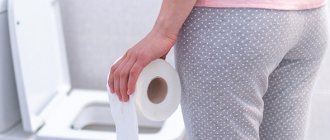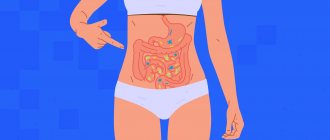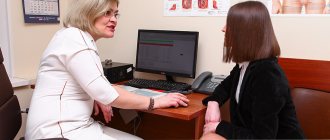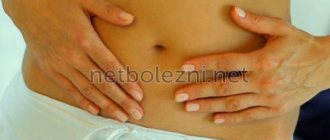Many serious diseases cannot be cured without the use of “heavy medical artillery” – antibiotics. This category includes medications that can stop the reproduction or completely destroy pathogenic bacteria that have entered the human body.
But drugs do not have selective ability, and along with pathological agents, the beneficial microflora of the gastrointestinal tract also dies. Very often, after a course of taking antibiotics, a person may experience severe stomach pain. Why does this happen and what is allowed to be done in this case?
Why does my stomach hurt after taking antibiotics?
After the drug enters the stomach, it dissolves under the influence of digestive enzymes and hydrochloric acid and enters the general bloodstream through the walls. The medicine is distributed throughout the body: the gastrointestinal tract is no exception. With long-term course use, one cannot exclude the development of dysbiosis - a pathological condition accompanied by the death of a significant amount of beneficial microflora of the gastrointestinal tract.
Typical signs of the condition are:
- disruption of the bowel movement process - diarrhea replaces constipation;
- increased gas formation;
- pain – most often a person is bothered by the lower abdomen;
- a feeling of fullness in the stomach even with a minimal portion of food eaten;
- food allergies;
- anemic conditions.
The strength of symptoms depends on the severity of dysbacteriosis. The difference between dysbiosis and intestinal infection is pain in the abdomen and/or stomach, regardless of food intake.
If abdominal pain develops after a course of antibiotics - especially if the condition worries the child - it is recommended to seek qualified medical help. After the tests have been carried out, the patient will be prescribed treatment appropriate to the condition.
It is recommended to take antibiotics with plenty of clean water.
How to minimize the risk of developing dysbiosis
If it is not possible to avoid long-term use of antibiotics, then efforts must be made to minimize the negative impact of drugs on the intestinal microflora. To avoid the development of pain, you must adhere to the following rules:
Pain in the abdomen and stomach
- It is highly undesirable to take the drug on an empty stomach. You need to eat something about 20 minutes beforehand.
- During the entire period of taking antibiotics, it is necessary to review the diet. The menu should contain products that have enveloping properties. These are slimy porridges, pureed purees, jelly, and pureed soups. It is necessary to completely eliminate spicy foods, marinades, coffee and strong tea, and alcohol. These products, in combination with antibiotics, can cause significant harm to the gastric mucosa.
- If you have a choice, it is advisable to replace the tablet format with injections. In this case, the medicine will enter directly into the bloodstream, bypassing the stomach.
- To take the medicine, you should use only clean water. The minimum volume is ½ cup.
- Simultaneously with the start of a course of antibiotics (especially for a child), it is necessary to start taking probiotics - agents that restore the normal balance of intestinal microflora. “I take antibiotics and definitely take probiotics.”
If the body gives too strong a negative reaction to treatment with drugs from the antibiotic category, then it is advisable to replace the prescribed medication. The selection of an analogue should be carried out by the attending doctor.
Dietary rules after treatment with antibacterial drugs
A diet after taking antibiotics will help restore the balance of intestinal microflora and get rid of dysbiosis. It is recommended to include in the diet:
- chicken and white fish broths,
- cutlets and meatballs made from lean meat,
- rice porridge,
- potatoes, carrots and other boiled vegetables,
- fresh cucumbers,
- greens - parsley, cilantro, dill,
- berries - strawberries, lingonberries and raspberries,
- jelly,
- kefir, cottage cheese, unflavored yoghurts,
- for dessert - honey in a small amount.
The following products are prohibited for consumption:
- hot seasonings - mustard, pepper,
- smoked meats and pickles,
- all fatty and fried foods with added spices,
- meat in marinade,
- sausages,
- canned food,
- kvass, alcoholic and carbonated drinks.
With strict adherence to the diet, after taking antibiotics, normal stools are restored, digestive disorders disappear, and abdominal pain stops.
How to restore the gastrointestinal tract after completion of treatment
If your stomach hurts from antibiotics, then you need to restore your intestinal microflora. There are several ways to eliminate dysbiosis by taking: probiotics, immunomodulators, hepatoprotectors.
It is also important to strengthen your diet by ensuring you receive more vitamins.
Probiotics
Probiotics help restore intestinal microflora disrupted by drug use. This can be both food and medicine. The composition of the latter is represented by beneficial bacteria - bifidobacteria and lactobacilli.
Treatment with drugs from the group of probiotics provides the following effects:
- the strength of immune defense increases;
- the growth of pathogenic microflora stops;
- normal functioning of the stomach and intestines is restored;
- all toxic substances released by pathogenic microflora are neutralized;
- triggering the production of B vitamins, which ensures normal functioning of the nervous system.
Linex is one of the most popular probiotics
Today, the most effective drugs from the probiotic category are: Linex, Hilak-Forte, Bifiform. The medications must be taken simultaneously with antibiotics, adhering to the principles of the recommended dietary intake.
Boosting immunity
Long-term use of antibiotics has a negative impact not only on the composition of the intestinal microflora. The drugs also disrupt the immune system. You can restore the body's defenses by taking immunomodulators. But the choice of medicine should be made by the attending physician.
A good immunostimulating effect is provided by: tincture of ginseng, Schisandra chinensis, Eleutherococcus. You need to take the drug for at least one calendar month.
Hepatoprotectors
In addition to the stomach and intestines, the human liver also suffers greatly from taking antibiotics. It is this organ that is responsible for removing all toxic components from the body, including breakdown substances of drugs.
Signs of liver damage include:
- feeling of heaviness in the right hypochondrium;
- yellowing of the sclera of the eyes.
Rosehip decoction shows good results in cleansing the liver. It is recommended to take the product up to 5 times a day after meals. If the symptoms of liver intoxication are too severe, then a drug from the category of hepatoprotectors - Karsil or Essentiale - may be recommended for use.
Intestines after taking antibiotics: warning signs, treatment
Not only medical specialists, but also conscious patients today know that after treatment with antibacterial drugs, it is extremely important to go through another stage of therapy - to restore the intestinal microflora after antibiotics.
Intestines after antibiotics: an unrecognized problem
Unfortunately, many people taking drugs from the category of “heavy artillery” still have doubts about the advisability of such methods of prevention. To understand how the intestines suffer after taking antibiotics, it is necessary to understand what such drugs are.
The term “antibiotics” (from Latin it literally translates as “against life”) refers to a wide class of drugs aimed at treating a wide variety of infections. The main function of antibacterial drugs is to suppress the development and number of pathogens that cause these same infections. Such drugs can disrupt the integrity of the cell wall of bacteria or cause fatal disruptions in their metabolism, disrupt the activity of certain enzymes...
In one way or another, the antibacterial drug deals with the causative agent of the infection, and it should be noted that, in most cases, antibiotics cope with this task just fine. However, the patient’s body inevitably suffers additional damage - along with pathogens (pathogenic bacteria), beneficial microorganisms, mainly populating the intestines, also die: this upsets the balance of the intestinal microflora (and sometimes quite critically).
Intestines after antibiotics: microflora suffers
Microflora is a significant part of a huge system of microorganisms that occupy their natural niches in various human organs. In general, microorganisms that are included in the category of normal microflora (normoflora) can be in different relationships with each other - friendly, and not very friendly. And any fluctuation (it is directly related to the use of antibiotics) in the quantitative composition of each type of microorganism is fraught with very unpleasant symptoms and consequences.
The intestine is one of the largest organs that has its own microflora, the influence of which on human health is almost impossible to overestimate, since its balance is associated not only with digestive function, but also directly affects the protective functions of the body. When taking antibiotics, many of the beneficial bacteria that populate the intestinal walls die, caught in the crossfire of the “heavy artillery” that was supposed to destroy the pathogens. And since a holy place is never empty, the place of dead beneficial bacteria is promptly colonized by unwanted representatives of the intestinal microflora - opportunistic microorganisms. Naturally, this does not have the best effect on the patient’s well-being...
Intestines after antibiotics: signals of a problem
Fluctuations in the balance of intestinal microflora very quickly affect a person’s well-being. First of all, symptoms of so-called dysbiosis develop: the patient begins to suffer from gastrointestinal symptoms, the spectrum and order of which is extremely diverse. So, initially, abdominal pain, diarrhea with nausea may develop, which are followed by constipation and bloating. Bowel problems vary, but usually do not go away on their own.
Taking antibiotics can damage not only the stomach, but the entire body as a whole, because the beneficial bacteria that populate the intestines are urgently needed for the normal function of the human immune system. That is why, after taking antibiotics, not only the intestines suffer - it is also possible to develop various allergic reactions, the nature of which, at first glance, is not very clear.
Intestines after antibiotics: recovery process
It is now obvious that the intestines after antibiotics need serious rehabilitation. As a rule, the process of microflora restoration includes several stages. The first of these is cleansing, since it is important to remove toxic metabolic products from the body. The second is “debugging” the work of the gastrointestinal tract: restoring the balance of the intestinal microflora, as a result of which the population of beneficial bacteria will be restored.
Intestines after antibiotics: Bionorm will restore order!
The domestically produced combination drug Bionorm will help you go through these stages and quickly restore the intestinal microflora damaged after taking antibiotics. Bionorm is the latest generation enterosorbent, the effectiveness and safety of which is based on the synergistic action of three active ingredients: lignin (actually, the sorbent), the prebiotic lactulose and cellulose, fiber, which improves intestinal motility.
Bionorm is non-toxic, does not cause unwanted side effects or interactions, and is not absorbed into the blood, as it works only in the intestines. To effectively detoxify the body after taking antibiotics and restore intestinal microflora, you should take Bionorm 1-1.5 hours before or after meals:
- adults and children over 12 years old – 2-3 tablets 3 times a day;
- children aged 6-12 years – 1-2 tablets 3 times a day;
- children aged 3-6 years – 1 tablet 3 times a day.
The drug is taken until the condition normalizes. The course of administration is up to 14 days, but can be changed by the attending physician. A repeat course of taking Bionorm may also be prescribed.
Well, in order to avoid various problems associated with an imbalance of the intestinal microflora, it would be wise to discuss with your doctor the question of how to protect the intestinal microflora after antibiotics at the stage of prescribing an antibacterial drug.
24-05-2016
Diet food
Knowing why the stomach may hurt after a course of antibiotics, it is necessary to prevent the development of dysbiosis. Following the principles of dietary nutrition can help with this. The duration of the diet is at least three calendar months.
From the daily menu you will need to completely exclude foods that trigger fermentation processes. These include black bread, cabbage, granulated sugar, fresh milk, grapes. At night, you should definitely drink a fermented milk product that contains bifidobacteria, for example, kefir.
To relieve cramps felt in the lower abdomen and painful syndrome, chamomile decoction helps well. For this purpose, it is recommended to drink ½ glass up to 5 times a day. It is worth noting that the drink does not affect the absorption of antibiotics.
If the patient is bothered by diarrhea, then rice water will help stabilize the stool. It has enveloping properties and helps relieve irritation from the gastric mucosa.
During the treatment of dysbiosis, a person is recommended to adhere to a certain diet
To eliminate intestinal spasms, you can brew ginger tea. You should drink ½ glass 3 times a day. In addition, it is good for nausea.
Antibiotic-associated intestinal lesions
The widespread use of antibacterial agents has led to the emergence of a new class of diseases associated with the negative effects of antibiotics on the intestinal mucosa and intestinal microbiota.
All intestinal lesions associated with antibiotic use can be divided into several types depending on the severity of clinical and endoscopic manifestations and the mechanisms that cause them. There are four types of antibiotic-associated intestinal lesions (AAIC) [1]:
- antibiotic-associated diarrhea;
- pseudomembranous colitis;
- segmental hemorrhagic colitis;
- mild illness (moderate malaise).
Antibiotic-associated diarrhea (AAD)
according to WHO regulations, it is defined as
three or more episodes of loose stool over 2 or more consecutive days, developing during or after the use of antibacterial agents
[1–3].
However, intestinal lesions are often not limited to diarrhea; more or less severe violations of the integrity of the colon mucosa, inflammation, and ulcerations can develop, which are defined as antibiotic-associated colitis.
Pseudomembranous colitis (PMC)
– the most severe manifestation of AAPC.
Although MVP is called antibiotic-associated, it is essentially an acute infectious disease caused by the microorganism Clostridium difficile.
Antibiotics are a kind of permissive factor, suppressing the normal microflora of the colon and creating conditions for the growth and reproduction of C. difficile [4–6].
Segmental hemorrhagic colitis (SHC)
is relatively rare and is associated with the microorganism Klebsiella oxytoca [1, 7].
Mild illness
(in exact translation – “mild illness”) is a mild or moderate malaise, manifested by a slightly pronounced disturbance of stool after taking antibiotics and does not correspond to the classical definition of AAD [1]. This condition is apparently caused by a temporary change in the spectrum of normal intestinal flora, partial suppression of obligate forms, but without the growth of pathogenic or opportunistic microorganisms. This symptom complex is probably closest to the concept of “intestinal dysbiosis after taking antibiotics” accepted in Russia [8].
Epidemiology and etiology of antibiotic-associated
On average, AAPC, primarily AAD, occurs in 5–30% of individuals treated with antibiotics [4]. The initial understanding of the development of AAD was associated with C. difficile. Asymptomatic carriage of C. difficile in different countries is detected in 1–3% of healthy individuals, in Japan it reaches 15%, but it is unknown whether this is associated with previous use of antibiotics. Data on the inoculation of C. difficile from the feces of patients with AAPC are contradictory. In patients with AAD, it is isolated in 20% of cases, and in the presence of MVP, according to various sources, the frequency of its inoculation is 50–100%, however, toxins A and B are found in all patients [4, 7].
C. difficile is a strictly anaerobic gram-positive rod that produces four entero- and cytotoxins. Toxins A and B play a major role in the development of AAPC, with toxin B having the most pronounced cytotoxic effect.
It was later discovered that only 10–30% of all cases of AAD are associated with C. difficile [8]. Other microorganisms that appear as a result of taking antibiotics and suppressing the normal intestinal microbiota, such as Clostridium perfringens, Staphylococcus aureus, Klebsiella oxytoca, Salmonela spp., Candida spp., Escherichia coli 0157:H7, are also capable of causing AAD [4, 7, 9] .
MVP in 100% of cases is caused by C. difficile [8]. The disease can occur sporadically, or it can be widespread in closed groups. MVP often manifests itself as a nosocomial infection. In medical institutions, if there is one sick person, the number of cases of MVP can grow exponentially. The route of infection is fecal-oral. Infection occurs through contact with patients, personnel, and contaminated objects.
The incidence of segmental hemorrhagic colitis is not precisely known, but is estimated to account for about 4% of all cases of AAPC [7, 9].
The first cases of the development of AAD and MVP were noted in patients taking lincomycin and clindamycin. The incidence of AAD when using these antibiotics is 10%, 1% of them develop MVP. Subsequently, a high incidence of AAD and colitis was noted when taking ampicillin (5–10%), amoxicillin/clavulanate (10–25%), and cefixime (15–20%). Other cephalosporins cause AAD in 2–5% of cases. The incidence of intestinal lesions when using other antibiotics is significantly lower. Thus, macrolides and tetracycline cause AAD (but not MVP) in 2–5% of patients, fluoroquinolones – in 2%, biseptol – in less than 1% of patients. No cases of MVP have been described after taking aminoglycosides and vancomycin [5, 10, 11].
Pathogenesis
The main mechanism by which antibiotics cause intestinal damage is not associated with the toxic effect of the drugs, but with the inhibition of resident intestinal microflora and the proliferation of opportunistic microorganisms that produce cytotoxins and enterotoxins.
Bacterial toxins have a number of negative effects. They cause direct damage to the intestinal epithelium and stimulate the secretion of water and electrolytes into the intestinal lumen. Colonization of the small intestine by opportunistic flora disrupts the metabolism of bile acids and carbohydrates, and bacterial toxins reduce the activity of membrane digestive enzymes in the small intestine, which leads to impaired digestion. Macrolide antibiotics, primarily erythromycin, stimulate the synthesis of motilin and, thus, contribute to increased peristaltic activity. The entire set of these mechanisms ultimately leads to the development of diarrhea and/or disruption of the integrity of the intestinal epithelium and inflammation.
The mechanisms of diarrhea in AAPC include four known pathophysiological components [10]:
- secretory (direct stimulation of water-electrolyte secretion by bacterial toxins);
- osmotic (impaired cavity and membrane digestion and accumulation of osmotically active substances in the intestinal lumen as a result of damage to brush border enzymes by bacterial toxins and impaired hydrolysis of nutrients in the small intestine);
- motor (when taking macrolides);
- exudative (with MVP due to inflammation and release of blood, mucus, pus, and protein exudate into the intestinal lumen).
Clinical picture
The clinical picture of AAD is caused by diarrheal syndrome of varying severity - from isolated episodes to severe profuse diarrhea, but without damage to the intestinal mucosa and visible inflammation. In severe cases, malabsorption syndrome develops.
MVP is characterized by diarrhea, often mixed with mucus and blood, cramping abdominal pain, fever, leukocytosis, and in severe cases, progressive intoxication and rapid dehydration. It is important to remember that symptoms can appear both after the first antibiotic dose and several weeks after stopping treatment. The severity of clinical symptoms varies depending on the severity of the disease. A mild course of MVP, characterized by moderately severe diarrhea with the patient generally feeling well, is rare. Typically, MVP is quite severe with all the symptoms described above. Sometimes a fulminant cholera-like course of the disease is observed. MVP occurs most severely in elderly patients in surgical hospitals. Mortality in these cases reaches 40%. Severe malabsorption syndrome, toxic dilatation of the colon, and colon perforation are described as complications of MVP. The development of dilatation is facilitated by the use of motility inhibitors (loperamide, anticholinergics), prescribed to relieve diarrhea and pain. Relapses of the disease are possible.
The clinical picture of SHC occupies an intermediate position between AAD and MVP, but is much less pronounced than with the latter. Slight or moderate diarrhea is characteristic, there may be a slight admixture of blood in the stool, there is no endotoxemia syndrome, there is no increase in temperature.
Diagnosis and differential diagnosis
The diagnosis of AAPC can be suspected based on the medical history (connection with antibiotic use) and the clinical picture. It should be borne in mind that clinical symptoms can appear both in direct connection with taking antibacterial drugs, and in the long term - after several days, weeks and even months. Therefore, it is necessary to collect information about the patient's use of antibiotics in the 6 months before the onset of symptoms.
The diagnostic search uses endoscopic examination (sigmoidoscopy or colonoscopy) with the collection of biopsy material, which is mandatory, and laboratory methods for determining pathogens (ELISA, PCR, bacteriological examination of stool).
With AAD, the mucous membrane is usually not changed. With MVP, characteristic yellowish-white or greenish plaques with a diameter of 3-4 mm to several centimeters form on the mucous membrane of the colon. Confluent plaques take on the appearance of membranes (pseudomembranes) tightly fused to the mucous membrane [5, 8]. These changes are most pronounced in the distal parts of the colon. The mucous membrane surrounding the pseudomembrane may not be changed, but more often it is brightly hyperemic and edematous. Sometimes pseudomembranes look like a solid yellowish coating and resemble diphtheria films. With purulent melting, the membranes can be torn away, exposing the ulcerated surface of the mucous membrane. Sometimes, with mild colitis, pseudomembranes may be absent, only a picture of catarrhal colitis with hyperemia and plethora of the mucous membrane is noted. These cases fall into the category of AAD rather than MVP. Since typical changes are most pronounced in the rectum and sigmoid colon, sigmoidoscopy is usually sufficient for diagnosis. The histological picture has no specificity. Biopsy specimens reveal small superficial necrosis, sometimes merging. The crypt architecture is not broken.
The presence of characteristic plaques or membranes on the mucous membrane in combination with the clinical picture that developed during or after taking antibiotics allows a correct diagnosis to be made with a high degree of certainty.
The endoscopic picture of GCH is characterized by pinpoint or confluent hemorrhages in limited areas of the colon mucosa [1]. There are no pseudomembranes typical for PMC.
To establish a diagnosis of AAPC, it is highly desirable to have bacteriological confirmation, since similar clinical symptoms occur in other diseases. There are, however, certain difficulties. Although it is believed that MVP is associated with C. difficile in 100% of cases, it is not always possible to confirm the diagnosis bacteriologically. It is possible to obtain a clostridia culture by stool culture only in 55% of cases. Usually, for screening, a simpler and faster diagnostic test is used to detect toxins A and B in the stool (or only toxin B, as the most aggressive) by ELISA, but this method has a low sensitivity of 62% [7, 11]. At the same time, approximately 34% of patients without diarrhea after taking antibiotics test positive for cytotoxin B [7]. In the presence of a characteristic clinical and endoscopic picture, detection of C. difficile is not necessary to confirm the diagnosis of MVP.
To confirm the diagnosis of AAD, microbiological examination is necessary, since there are no characteristic endoscopic changes. The absence of a positive ELISA test for toxins does not exclude the diagnosis of clostridial AAD. Given the low sensitivity of ELISA for detecting C. difficile toxins in stool, if the results are negative, the PCR method should be used to detect the microorganism in stool. In case of negative PCR results, the presence of C. difficile infection can be excluded, but it must be remembered that AAD can be caused by other microorganisms.
In case of SHS, C. difficile and its toxins are not detected, and Klebsiella oxytoca is cultured from feces [9].
Summarizing the above, we can make several points regarding the diagnosis of AAPC:
- with AAD - connection with taking antibiotics, diarrhea syndrome in accordance with the definition, endoscopic picture of the colon mucosa without visible deviations from the norm. Determination of the pathogen in feces is highly desirable. C. difficile and its toxins are not always detected, which does not exclude the diagnosis of AAD caused by C. difficile. The diagnosis can be confirmed by PCR. The relationship of the disease with other pathogens and the need to identify them should be taken into account;
- with MVP - connection with taking antibiotics, diarrhea syndrome, blood in the stool, fever, intoxication, characteristic endoscopic changes. Detection of C. difficile by any method is desirable but not required;
- with SGC - association with the use of antibiotics, moderate diarrhea, sometimes with blood, there are no pseudomembranes characteristic of MVP, but in limited areas of the colon mucosa, pinpoint or confluent hemorrhages are visible. Stool examination reveals no C. difficile and its toxins; Klebsiella oxytoca is cultured from feces ;
- for mild illness – a connection with taking antibiotics is possible, but not obvious, there are no stable clinical and endoscopic symptoms. C. difficile and its toxins, as well as Klebsiella oxytoca, are not detected. During bacteriological examination, various temporary disturbances in the composition of the normal microbiota of the colon are possible.
Differential diagnosis of AAPC is carried out with ulcerative colitis, Crohn's disease, infectious colitis and enterocolitis, amoebic and bacterial dysentery.
Treatment
A prerequisite for successful treatment of any variant of AAPC is the immediate discontinuation of the antibiotic that caused it, which determines the involution of symptoms and the prognosis of the disease.
In most cases, with clinically pronounced AAD without symptoms of colitis or if it is suspected, this measure is sufficient. Diarrhea disappears within 3–5 days after stopping the antibiotic. It is advisable to prescribe drugs based on non-pathogenic fungi Sacharomyces boulardii (Enterol), 2 capsules 3 times a day for 7–10 days.
However, with MVP, unlike any other type of AAPC, this measure is not enough. To suppress the growth of C. difficile, antibacterial agents are needed that primarily affect the anaerobic flora. First-line therapy is metronidazole 250 mg 4 times a day for 7–10 days. If there is no effect, vancomycin is taken orally, the dose of which can vary from 500 mg to 2 g per day depending on the severity of MVP for 7-10 days or rifaximin 200 mg 3 times a day for 10 days. The advantage of both drugs is their low absorption from the intestine, so a high concentration of the drug is achieved in the lumen, which leads to rapid suppression of C. difficile and elimination of its toxins. In case of severe MVP, vomiting, or the inability to take drugs orally, metronidazole (100 ml of 0.5% metrogil solution 3-4 times a day) or vancomycin in a therapeutic dose is administered intravenously. Vancomycin and metronidazole are comparable in effectiveness [6, 7, 11]. As for rifaximin, there have been no such comparative studies yet. This therapy is considered the standard of treatment, but it is not always successful. Preparations of non-pathogenic fungi Sacharomyces boulardii (Enterol) give a good effect as an additional therapy, 2 capsules 3 times a day for 10–14 days.
Non-pathogenic yeasts of the genus Sacharomyces boulardii are obtained from tropical plants and fruits. S. boulardii belongs to the ascomycetes that have genetically determined resistance to almost all groups of antibiotics, sulfonamides and other antimicrobial agents. At the same time, S. boulardii does not suppress the growth of obligate microorganisms in the intestinal cavity.
S. boulardii
It is resistant to the action of hydrochloric acid and, when taken daily, is found in all parts of the gastrointestinal tract. This yeast is a transient flora for humans, therefore, 2–5 days after the end of taking the drug, it is completely eliminated from the body without side effects. Enterol is a locally acting intestinal antiseptic and is not absorbed from the gastrointestinal tract. The antimicrobial effect of Enterol has been established in vitro and in vivo against a wide range of pathogens of intestinal infections, opportunistic microorganisms and protozoa, including those that can cause AAPC: C. difficile, Salmonella typhimurium, Escherichia coli, Candida albicans, Candida krusei , Candida pseudotropicalis, various types of Klebsiella and staphylococci [6, 12].
The mechanism of action of Enterol in AAPC includes several aspects:
- direct antimicrobial effect;
- direct and indirect antitoxic effect (binding of microbial toxins in the intestines);
- antisecretory effect (reduces intestinal secretion of water and electrolytes during secretory diarrhea);
- trophic effect (stimulates the enzymatic activity of intestinal disaccharidases and other digestive enzymes);
- nonspecific immunomodulatory effect.
The trophic and immunomodulatory effect of Enterol is due to its ability to synthesize polyamines (spermine, spermidine). Polyamines stimulate the activity of digestive enzymes in the small intestine (increase the production of saccharidases-lactase, maltase, sucrase and aminopeptidases). The trophic effect of Enterol is extremely important in the damaging effects of bacteria and their toxins on the intestinal mucosa, damage to the mucous barrier and a decrease in the activity of digestive enzymes. In addition, polyamines stimulate the synthesis of IgA and components of other immunoglobulins in the intestinal mucosa.
The antibacterial and antitoxic effect of Enterol allows it to be successfully used as a primary remedy for mild cases of AAD and SCH and as an adjuvant for severe cases of AAD and MVP. The trophic, immunomodulatory and digestion-stimulating effect of the drug helps overcome the consequences of AAPC.
Double-blind randomized studies conducted in various infections requiring antibiotics have demonstrated that the use of S. boulardii reduces the incidence of AAD by 2-4 times. Thus, in one study that included 388 patients, the incidence of diarrhea in the group of patients taking S. boulardii with antibiotics was 4.5% versus 17.5% in the placebo group [13]. In two other studies (180 and 193 patients), these values were 9.5% versus 22% and 7.2% versus 14.6%, respectively [14, 15]. In these studies, the causative agent of diarrhea was not identified. When studying the relapse rate of chronic colitis caused by C. difficile in adults, it was shown that when a standard antibiotic (vancomycin or metronidazole) was combined with S. boulardii, the relapse rate was 26.3%, and when combined with placebo, it was 44.8%, Moreover, the frequency of determination of clostridium toxins in feces decreased proportionally [14, 15]. In 19 children with diarrhea that began at 2 weeks of age, C. difficile toxin B was detected in the stool. 1 week after the start of treatment with S. boulardii, the frequency of bowel movements decreased in 95% of children; after 2 weeks, the toxin was detected in only 15% of patients, and after 4 weeks – in 7% [16].
In severe cases of AAD and MVP, in addition to basic treatment, effective sorbents (Smecta) or dietary fiber with sorption properties (Lactofiltrum) are indicated. Oral and parenteral rehydration and detoxification are actively carried out.
Relapses of MVP are possible, the frequency of which reaches 30%. For relapses, repeat 7-10-day courses of vancomycin, metronidazole or rifaximin are used. Sometimes therapy continues for several weeks with a gradual dose reduction. After a course of antibiotics, Enterol or lactose-containing probiotics are prescribed for a long period to prevent relapse. In the acute phase of the disease, one should avoid prescribing antidiarrheals of the loperamide group, other opiates and anticholinergics, which can cause toxic dilatation of the colon. If complications develop (toxic dilatation, colon perforation), surgical treatment is performed. The method of choice is coloproctectomy.
Treatment of GCS can be carried out with standard dose rifaximin or Enterol. Mild illness syndrome does not require special treatment.
Forecast
The prognosis of AAPC, including MVP, is generally favorable and depends on timely diagnosis, early withdrawal of antibiotics that caused the disease, rapid initiation of adequate treatment and the severity of the disease. Less favorable prognosis in older patients.
Prevention
Prevention of AAD consists of the rational use of antibacterial agents strictly according to indications and the immediate discontinuation of the drug at the first episodes of diarrhea, even before the diagnosis of AAD is established. During the period of taking antibiotics, it is recommended to reduce the carbohydrate content in the diet, since carbohydrate substrates are a good environment for the proliferation of opportunistic bacteria that can cause AAD. As a preventive measure, it is possible to use Enterol, prebiotics or microbial metabolites against the background of antibacterial therapy, and after its completion - probiotics containing enterococci and lactobacilli. Prevention of nosocomial infection is based on strict adherence to sanitary and epidemiological measures while a patient with C. difficile infection is in the hospital .
Restoring the intestines with folk remedies
There are many traditional medicine recipes that allow you to restore intestinal function after long-term use of antibiotics. To eliminate the symptoms of indigestion that accompany dysbiosis, you can use the following recipe. To prepare the product you will need:
- onion – 1 pc.;
- garlic – 2 cloves;
- kefir – 500 ml;
- dill/parsley – 4 sprigs;
- chamomile (inflorescences) – tsp;
- St. John's wort (herb) – tsp;
- water – 500 ml.
Preparation:
- Chop the onion and garlic and pour in kefir.
- Place chopped herbs and dry ingredients in it.
- Add water and mix well.
- Leave the mixture for 30 minutes and filter.
The resulting drink should be drunk throughout the day. The following recipe is an herbal infusion. You need to mix St. John's wort (tsp), a third of a teaspoon of tansy and half a spoon of sage herb. Place the mixture of herbs in a thermos and pour boiling water (200 ml). Leave for 2 hours and filter. Drink throughout the day in small sips before meals.
Nettle tea can help the body recover after a course of antibiotics. Duration of treatment – 2 weeks. Brew 2 tablespoons of chopped nettle in 2 liters of boiling water. The tea must brew. Before drinking, the drink must be filtered and drunk throughout the day.

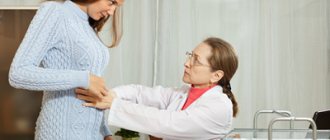


![Rice. 2. Clinical stigmas of chronic atrophic gastritis [4] 2. Clinical stigmas of chronic atrophic gastritis [4]](https://zakam.ru/wp-content/uploads/ris-2-klinicheskie-stigmy-hronicheskogo-atroficheskogo-gastrita-4-fig-2-330x140.jpg)

